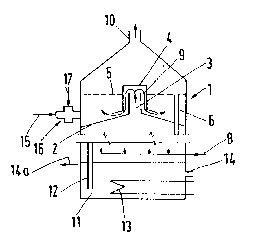Some of the information on this Web page has been provided by external sources. The Government of Canada is not responsible for the accuracy, reliability or currency of the information supplied by external sources. Users wishing to rely upon this information should consult directly with the source of the information. Content provided by external sources is not subject to official languages, privacy and accessibility requirements.
Any discrepancies in the text and image of the Claims and Abstract are due to differing posting times. Text of the Claims and Abstract are posted:
| (12) Patent Application: | (11) CA 2123033 |
|---|---|
| (54) English Title: | PROCESS AND APPARATUS FOR SUPPLYING ALKALI CHLORATE AND ACID TO A REACTOR FOR PRODUCING CHLORINE DIOXIDE |
| (54) French Title: | PROCEDE ET APPAREILLAGE POUR ALIMENTER EN CHLORATE DE METAL ALCALIN ET EN ACIDE UN REACTEUR DESTINE A LA PRODUCTION DE DIOXYDE DE CHLORE |
| Status: | Deemed Abandoned and Beyond the Period of Reinstatement - Pending Response to Notice of Disregarded Communication |
| (51) International Patent Classification (IPC): |
|
|---|---|
| (72) Inventors : |
|
| (73) Owners : |
|
| (71) Applicants : |
|
| (74) Agent: | ROBIC AGENCE PI S.E.C./ROBIC IP AGENCY LP |
| (74) Associate agent: | |
| (45) Issued: | |
| (22) Filed Date: | 1994-05-06 |
| (41) Open to Public Inspection: | 1994-11-14 |
| Availability of licence: | N/A |
| Dedicated to the Public: | N/A |
| (25) Language of filing: | English |
| Patent Cooperation Treaty (PCT): | No |
|---|
| (30) Application Priority Data: | ||||||
|---|---|---|---|---|---|---|
|
- 7 -
ABSTRACT
To produce a gaseous mixture of chlorine dioxide
and chlorine, alkali chlorate solution is reacted with an
acid, such as hydrochloric acid, in a reactor that comprises
one or more reaction stages. The alkali chlorate solution
and the acid are first passed jointly through a mixing cham-
ber to form a mixed solution, which is supplied from the
mixing chamber to the uppermost reaction stage of the reactor.
Note: Claims are shown in the official language in which they were submitted.
Note: Descriptions are shown in the official language in which they were submitted.

2024-08-01:As part of the Next Generation Patents (NGP) transition, the Canadian Patents Database (CPD) now contains a more detailed Event History, which replicates the Event Log of our new back-office solution.
Please note that "Inactive:" events refers to events no longer in use in our new back-office solution.
For a clearer understanding of the status of the application/patent presented on this page, the site Disclaimer , as well as the definitions for Patent , Event History , Maintenance Fee and Payment History should be consulted.
| Description | Date |
|---|---|
| Time Limit for Reversal Expired | 1997-05-06 |
| Application Not Reinstated by Deadline | 1997-05-06 |
| Deemed Abandoned - Failure to Respond to Maintenance Fee Notice | 1996-05-06 |
| Inactive: Adhoc Request Documented | 1996-05-06 |
| Application Published (Open to Public Inspection) | 1994-11-14 |
| Abandonment Date | Reason | Reinstatement Date |
|---|---|---|
| 1996-05-06 |
Note: Records showing the ownership history in alphabetical order.
| Current Owners on Record |
|---|
| METALLGESELLSCHAFT AKTIENGESELLSCHAFT |
| Past Owners on Record |
|---|
| GERHARD JEDLICKA |
| METWALLI ALI |